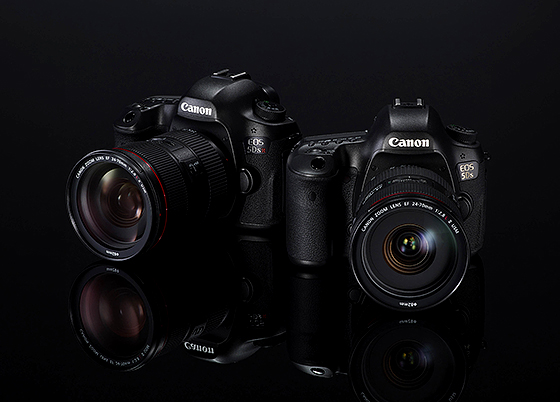CANON EOS 5DS AND 5DSR:
PUZZLED ARRIVAL.
February 6, 2015.
Although I use technology from another brand, I was interested in the introduction of both new models today – Canon is entering the "medium format" area for the first time (although the resolution of over 20 Mpx can already be considered "medium format"), with a resolution 14 Mpx higher than the Nikons D8xx series.

For landscape, still life, etc. photographers, who own Canon lenses and accessories, this is certainly good news, of course when printing large format prints. But ... While Nikon used sensors on the D800 and 810 that did not suffer from color depth and dynamic range (on the contrary) at high resolution, Canon does not seem to have cooperated with Sony in the end, and the sensor is of its own (or whoever) origin. Which, on the one hand, is good news, for example for me, to whom the different character of Canon sensors suits as ev. a different way of expressing art (if I had the need), but bad for those, who would like to get the same opportunity to brighten shadows for the bold price of a new body and also to have as vivid, pure colors as with Nikon. It's tricky at all with those colors - if you don't have the opportunity to compare, you will find the good ones in Canon first, perhaps even excellent in time. But all this only until we open RAW in the second window (JPG is in this, as in most cases, useless) similar scene from Nikon. Here, the difference in color depth is clearly visible.
On the other hand, it is sometimes difficult to tame these colors so that as a whole they look harmonious. Although Chuck Westfall of Canon claimed in a interview for dpreview, that the sensor came from Canon's development and had nothing to do with Sony, the objectivity of this statement is, of course, directly proportional to Chuck's loyalty to his employer. If the new sensor doesn't really come from Sony and Canon couldn't shift its features in any way, then this is a really puzzled step.
The body remained exactly the same (is there still the black tape inside, which in all 5DIIIs prevents the penetration of light - or have they finally done it properly?). Maybe the introduction of new models could be used for some improvements in control (for example, the strange Rate button would deserve a change to a photographic function), when the price exceeds CZK 100 000. Added the option to lock the mirror 1/8 - 2 seconds - yes, the rushes cheer, but it seems like pure nonsense to me - on the contrary, the D800 has an excellent extension of the lock time up to 3 seconds. So the novelty is completely useless - if I'm in a hurry, I will use a proper tripod and I can press the shutter button with my hand without lock it even at critical times (tested). If not, I will connect a wire or radio shutter trigger and for Nikon 3 seconds or Mup, for Canon 2 or 10 seconds self-timer.
Very good is minimum (or perhaps no ones) news for video boys - Canon convinced the failure of their video section, a big drop in the meaningless price of a pointless 1Dc, etc. Still throw the switch at the viewfinder, but it comes, when this fasionable stupidity (hybridisation of professional DSLRs with camcorders) again noise out, where it belongs from the beginning.
In general, even from the comments of those, who attended press conferences, there is a more or less ill-concealed embarrassment over this "development" between the lines. Bryan Carnathan writes, how the sensor solution in 5Dsr will save Canon costs ... The mistake is that for (again) the increased price Canon chose only the D800E solution for the 5Dsr, thus, canceling the effect of the AA filter with the filter inverted, and not from the D810 and medium format sensors, ie its complete removal.
However - we'll see. Personal experiences in particular will be important. But we will wait for them, because the new bodies will come to the shops (unless something changes) at the earliest in July 2015.
And what is the real difference in resolution of 50 vs. 36 Mpx? 22 cm ... look:
5Ds (r):
50 Mpx = 8688 x 5792 = 147 x 98 cm / 150 dpi.
D800 (E, 810):
36 Mpx = 7360 x 4912 = 125 x 83 cm / 150 dpi.
From personal experience, I can finally recommend the best way to top-quality large-format photography - stitching of images. Of course, it is not always possible to use it, but if it does, you will achieve truly unprecedented results. With Nikon, Canon, Pentax ... it doesn't matter if you see, feel and can transfer it to a photograph. Give it a try.
© Martin Mojzis.
Photograph: © Canon Inc. – Press.
UPDATED FEBRUARY 9, 2015:
Everything is clear. Canon fans have little reason to rejoice. The sensor is of the same type as the 5DIII and the dynamic range according to the Canon Professional Network (CPN) as well. Due to the resolution, the color depth could be slightly higher than with 5DIII. Probably the biggest limitation, that can be expected from Canon's new sensors, is the noticeably less ability to brighten shadows in contrast scenes compared to Nikon. All this for a price CZK 20 000 higher than the D810. In other words, Canon preferred cheap marketing (the highest possible resolution, but the outdated design of the sensor) to real quality, ie even fewer pixels, but great dynamics and color depth, along with a 16-bit AD converter.
►To the beginning of the article.
►Overview of all articles.
►Homepage.
►Site Map.